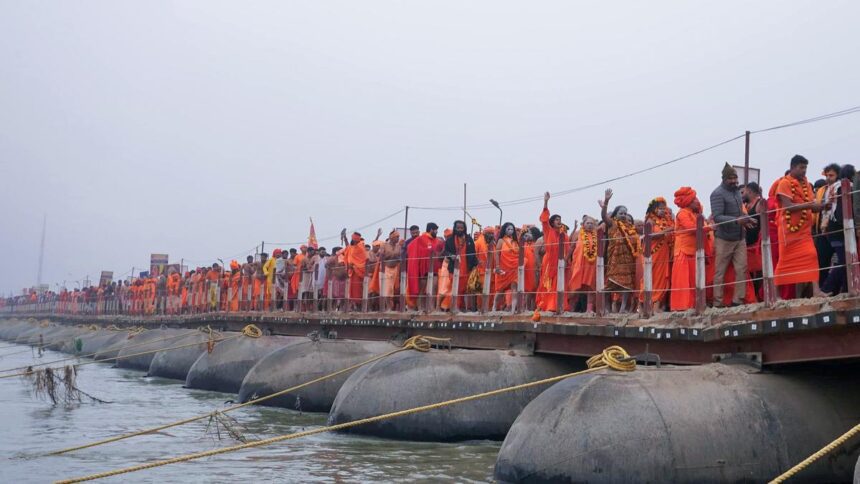Pontoon bridges, inspired by a 2,500-year-old Persian technique, are serving as crucial connections between the Sangam and the vast 4,000-hectare ‘akhada’ areas at the Maha Kumbh Mela. This historic event is renowned for being the largest cultural-spiritual gathering in the world.
A dedicated workforce of over 1,000 individuals toiled for more than a year, often putting in ten-hour days, to construct pontoons for an unprecedented total of 30 bridges. These structures represent the largest pontoon project ever undertaken.
With the use of over 2,200 black floating iron pontoons, each weighing around five tonnes, the bridges facilitate the movement of vehicles, pilgrims, sadhus, and workers at this grand event. Each bridge, often referred to as a floating marvel, is engineered to withstand a maximum weight of up to five tonnes.
Vivek Chaturvedi, the Additional District Magistrate of Mahakumbh Nagar, emphasized the significance of these bridges. “They are integral to the Maha Kumbh, offering a low-maintenance solution to manage the vast crowds. However, their operation demands continuous monitoring to ensure the safety and smooth flow of devotees. Each bridge is equipped with CCTV cameras, and footage is monitored in real-time at the Integrated Command and Control Centre,” he stated.
Before being put into use, each bridge underwent extensive testing to ensure its structural integrity and ability to accommodate a large number of individuals simultaneously. The design and construction processes draw from historical examples; pontoon bridges date back to 480 BC, when they were utilized by Xerxes I, the Persian king, during his campaign against Greece. Additionally, these types of bridges were implemented by the Zhou dynasty in China in the 11th century BC.
India’s history with pontoon bridges began in October 1874, when the first pipa bridge was constructed over the Hooghly River, linking Howrah and Kolkata. Engineered by British engineer Sir Bradford Leslie, this bridge was supported by wooden pontoons but was eventually dismantled after sustaining damage from a cyclone in 1943. In its place, the iconic Rabindra Setu, or Howrah Bridge, was built.
The Maha Kumbh Mela, a monumental religious event held every 12 years, is currently taking place in Prayagraj, starting from January 13 and lasting for 45 days. To date, over seven crore pilgrims have visited the Sangam, the confluence of the Ganga, Yamuna, and the mythical Saraswati rivers.
Alok Kumar, an engineer from the Public Works Department, described the construction of the pipa bridges as temporary structures crafted with large hollow iron containers that float on the water. Referred to locally as “pipe ka pul,” these bridges were designed not just for public access but also to accommodate the ceremonial entry of 13 akhadas, along with the movement of chariots, elephants, horses, and over 1,000 vehicles during the auspicious Amrit Snan.
Entrusted with the task in August 2023, Kumar explained, “We utilized 2,213 pontoons—an all-time high—to build these 30 pipa bridges. More than 1,000 workers, engineers, and officials worked tirelessly, often for 14 hours each day. The construction was completed last October and subsequently handed over to the mela administration.”
The construction techniques involved lowering hollow pontoons made of reinforced iron sheets into the river using cranes. Subsequently, girder beams were placed on top and secured with nuts and bolts, utilizing hydraulic machinery for precise positioning. The bridges were further stabilized with thick wooden planks, sandy soil, and iron angles, and covered with checker plates to support the traffic of pilgrims and vehicles.
“The pontoons, weighing approximately five tonnes each, float due to Archimedes’ principle. When an object displaces water, it experiences an upward force equal to the weight of the displaced water, which is how these heavy pontoons remain afloat,” Kumar elaborated. “The design allows them to bear a maximum weight of five tonnes. Exceeding this limit could compromise the integrity of the bridge, making crowd management crucial.”
The Uttar Pradesh government has reported that the total cost for constructing the 30 pipa bridges was Rs 17.31 crore. Specific bridges, including the one connecting Shri Nagvasuki Temple to Jhusi, represent the highest expenditure at Rs 1.13 crore, while the Gangeshwar and Bharadwaj bridges ranged from Rs 50 lakh to Rs 89 lakh in costs.
After the conclusion of the Maha Kumbh, these bridges will be disassembled and safely stored for future use in other locations. Some will be kept in Sarainayat (Kenihar), Trivenipuram, and the Parade Ground in Prayagraj, while others may be repurposed as temporary structures across various districts in Uttar Pradesh.










